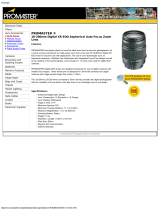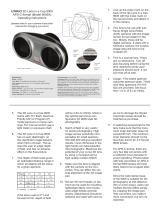Tamron AF014C700 User manual
- Category
- Camera lenses
- Type
- User manual
This manual is also suitable for

®
AF18-200mm
F/3.5-6.3 XR Di II LD Aspherical [IF] Macro
(Model A014)
Thank you for purchasing the Tamron lens as the latest addition to
your photographing equipment. Di II lens (Digitally Integrated)
series are designed for digital SLR cameras with image sensors
equivalent to APS-C size. (approx. 15.5 x 23.2mm). Before using
your new lens, please read the contents of this Owner's Manual
thoroughly to familiarize yourself with your lens and the proper
techniques for creating the highest quality images possible.With
proper handling and care, your Tamron lens will give you many
years of photographing beautiful and exciting pictures.

NOMENCLATURE
1. Lens hood
2. Hood attaching alignment mark
3. Hood attached indicator
4. Hood attaching bayonet ring
5. Distance index
6. Distance scale
7. Focusing ring
8. Zooming ring
9. Focal length scale
10. Zoom index mark
11. Zoom lock switch
12. Lens mount / Lens mount contacts (Nikon)
13. AF-MF switch (Canon)
14. Lens attachment mark

FOCAL LENGTH
18 ~ 200 mm
MAXIMUM APERTURE F/3.5-6.3
ANGLE OF VIEW 75 deg. 33’ - 7 deg. 59’
LENS CONSTRUCTION
(GROUPS / ELEMENTS) 13/15
MINIMUM FOCUS DISTANCE 0.45 m
FILTER SIZE 62 mm
LENGTH 83.7 mm
DIAMETER 73.8 mm
WEIGHT 398 g
SPECIFICATIONS

ATTACHING AND REMOVING THE LENS
* How to mount the lens
Remove the rear cap of the lens. Align the lens attachment mark on the lens barrel
with its counterpart on the camera mount and insert the lens. Rotate the lens clock-
wise until it click-locks. For Nikon and Pentax models, align the lens attachment mark
on the camera and the zoom index on the lens to attach the lens.
* How to detach the lens
Pressing the lens release button on the camera down, turn the lens counter-clockwise
(in case of Nikon, clockwise), and lift the lens off the camera's lens mount.
**The image circles of Di II lenses are designed to match the digital SLR cameras
using the image sensors equivalent to APS-C (approx. 15.5 x 23.2mm). Do not use Di II
lenses with cameras using image sensors larger than APS-C. Using Di II lenses with
such cameras may cause vignetting on the image.
FOCUSING (AUTOFOCUS)
Switch the camera or lens to AF mode. Press the shutter button lightly while viewing
through the camera's viewfinder, the lens focuses automatically. An in-focus mark will
light when lens focuses on the main subject sharply. Press the shutter button further
to photograph.
* When set on AF mode, interfering with the focusing ring may cause serious damage
to the lens mechanism.
* Select between the autofocus and manual focus modes by using the AF/MF switch
on the camera in case of Nikon, Konica Minolta, or Pentax lens.The lens for Canon
cameras has the AF/MF switch on the lens.
FOCUSING (MANUAL FOCUS)
Switch the focusing mode switch of the camera to manual focusing mode (MF) in
case if Nikon, Konica Minolta, or Pentax. In case of Canon camera, switch the AF/MF
switch on the lens to MF. Focus by manually rotating the focusing ring while viewing
through the camera's viewfinder. The main subject in the viewfinder will be sharp
when the lens is focused correctly.
* Even when in MF mode, turning the focusing ring while pressing the shutter button
halfway, the focus aid function lamp lights up when the picture is in focus.
* At infinity, make sure the image in the viewfinder appears sharp.The infinity posi-
tion on the lens is made with certain allowances to insure proper focus under a vari-
ety of conditions.

ZOOMING
Rotate the zooming ring of the lens while viewing through the camera's viewfinder
and compose your image at the chosen focal length.
ZOOM LOCK SWITCH
Model A014 is equipped with a zoom lock switch mechanism which prevents the lens
barrel from extending towards longer focal lengths while being carried around the
neck, or off the shoulder. Activate the switch at the shortest setting to stop the lens
barrel from rotating and extending.
* How to activate the zoom lock switch mechanism
1. Locking: Set the zoom ring on the lens to the shortest position. Move the zoom
lock switch toward the camera to lock the zooming ring.
2. Releasing: Push the zoom lock switch back up. The zooming ring is now released
and can be rotated.
** Zoom lock switch cannot be activated unless the lens is set to the shortest posi-
tion. Do not force the lock switch or try to rotate the zooming ring while locked;
doing so may damage the lens.
** The zoom lock mechanism is made to prevent the lens barrel from extending while
carried around the neck.When not locked, the zoom lens may change its focal length
during a long exposure in a low or high angle.
LENS APERTURE AND AE MODE
Please follow the instruction manual of your camera.
LENS HOOD
A bayonet type lens hood is provided as standard equipment.We recommend
shooting with the hood attached whenever possible as the lens hood eliminates stray
light which is harmful to the picture. However, please be aware of the precautions
written below when your camera is equipped with a built-in flash.
* Attaching the Lens Hood
Align the index mark on the hood with the corresponding index mark on the lens.
Press the hood lightly onto the hood attaching bayonet ring and then rotate it clock-
wise to secure.The lens hood will be securely held as the mark "TAMRON O" comes to
the top.When attaching the lens hood, hold the focusing and zoom control rings so
that they are not rotated unintentionally.

LENS HOOD (Continued)
** Pay particular attention to align the hood attaching indexes when using zoom
lenses including wide-angle (35mm or wider) settings. Improper attachment of a
hood for wide-angle zoom lenses may cause large shadowed areas in your pictures.
* Stowing lens hood on the lens
1. Reverse the lens hood. Point the lens toward the opening, and then align the
hood attachment mark on the lens with the (TAMRON O) alignment on the hood.
2. Turn the hood clockwise until the alignment mark is at the top to set it.
PRECAUTIONS IN SHOOTING
* The optical design for this lens takes into consideration the various features of digi-
tal single reflex cameras. However, due to the configuration of the digital single reflex
cameras, even when the autofocus accuracy is within specifications, the focal point
may be a little forward or behind the optimum point when shooting with autofocus
under some conditions.
* The image circles of Di II lenses are designed to match the digital SLR cameras using
the image sensors equivalent to APS-C. Do not use Di II lenses with cameras using
image sensors larger than APS-C. Using Di II lenses with such cameras may cause
vignetting on the image.
* The Tamron lens described here employs an internal focusing system [IF]. Because of
the characteristics of this optical design, the angles of view at distances other than
infinity are wider than that of the lenses applying an ordinary focusing system.
* When the built-in flash on the camera is used, adverse photographic phenomena
such as corner illumination fall-off or vignetting at the bottom part of the image may
be observed.This is due to the inherent illumination of the coverage of the built-in
flash, and/or the relative position of the flash to the edge of the lens barrel which
causes shadows on image. It is strongly recommended to use a suitable separate flash
unit provided by the camera manufacturer for all flash photography.
* Do not forcibly turn the focusing ring when the lens in set in AF mode. Doing so
could damage the lens and/or camera.
* Certain camera models may indicate the maximum and minimum aperture values
of the lens as approximate numbers.This is inherent to the design if the camera and
not an indication of error.

TO ENSURE LONG-TERM SATISFACTION
* Avoid touching the glass element surface. Use a photographic lens cloth or blower
to remove dust from the lens element surface. When not using the lens, always place
a lens cap on it for protection.
* Use a lens cleaning tissue or lint cloth with a drop of cleaning solution to remove
fingerprints or dirt on the glass lens surface with a rotary motion from the center to
the edge. Use a silicon cloth to clean your lens barrel only.
* Clean the lens barrel with a silicon cloth. Do not use benzene or paint thinner or
other organic cleansers.
* Mildew is an enemy of your lens. Clean the lens after shooting near water or in any
humid place. Store your lens in a clean, cool and dry place. When storing the lens in a
lens case, store it with commercially available drying agent such as silica gel, and
change the agent occasionally. If you find mildew on your lens, consult an authorized
repair shop or nearby photographic store.
* Do not touch the lens-camera mount contacts since dust and/or dirt stains may
cause a contact failure between the lens and camera.
* When using your equipment in an environment where the temperature changes
from one extreme to the other, make sure to put your equipment temporarily in a
case or plastic bag for a length of time in order to go through a gradual temperature
shift. This will reduce potential equipment trouble.
TAMRON USA, INC.
10 AUSTIN BLVD.
COMMACK, NY 11725
-
 1
1
-
 2
2
-
 3
3
-
 4
4
-
 5
5
-
 6
6
-
 7
7
Tamron AF014C700 User manual
- Category
- Camera lenses
- Type
- User manual
- This manual is also suitable for
Ask a question and I''ll find the answer in the document
Finding information in a document is now easier with AI
Related papers
Other documents
-
Sigma 50-200mm f4.5-5.6 DC OS HSM Owner's manual
-
Sigma 70-300mm f4-5.6 DG OS Owner's manual
-
Sigma 18-200mm f3.5-6.3 DC OS Owner's manual
-
Sigma 18-125mm F3.5-5.6 DC OS HSM Owner's manual
-
Sigma 521 Owner's manual
-
Sigma CAN 35MM User manual
-
Sigma CAN 35MM User manual
-
 Promaster AF18-200XR EDO Aspherical Auto Focus Zoom Lens For Pentax AF Owner's manual
Promaster AF18-200XR EDO Aspherical Auto Focus Zoom Lens For Pentax AF Owner's manual
-
Samyang SY14M-C User manual
-
 Loreo 9005 Operating instructions
Loreo 9005 Operating instructions








